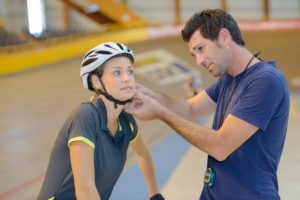How To Prevent and Treat Florida Bicycle Injuries
Bicycle injuries can be divided into three categories: Injuries caused by falls and collisions, injuries caused by inadequate/improper/malfunctioning equipment, and wear and tear injuries caused by physical activity. Following is a guide to prevention and treatment of some common cycling injuries.
Muscle strain – The best way to prevent muscle strain is to warm up before a ride and to pay attention to your body while you are exercising. Continuing to exercise after your muscles are hurting, or exercising without a warm-up, can result in a strained (pulled) muscle. Symptoms include soreness, stiffness, weakness, and loss of mobility. Sometimes the area around the muscle might be bruised.
Sprains – A sprain is an injury to the ligaments that connect bones. Sprains occur when a ligament is overstretched or torn, often caused by twisting one’s knees, falling on the side of one’s foot, or landing on one’s outstretched hands. The recommended treatment for sprains depends upon their severity. A minor sprain, with minimal pain and swelling, and little to no loss of function, can be treated at home in the same way as a strain.
- Apply ice to a strained muscle as soon as possible after the injury. Apply an ice pack to the area for 15 minutes at a time. After the first few hours after the injury, apply heat to the area, and/or soak in Epsom salts or just hot water.
- Elevate the area to reduce swelling. Keep the injured area above heart level to allow fluids to leave the area.
- Rest the strained muscle.
- Anti-inflammatory medication. Over the counter, anti-inflammatory medicines will also help the strain heal more quickly but should be used temporarily.
- Gentle stretching or gentle massage can help stimulate blood circulation and promote healing.
- You should seek medical treatment with any strain or sprain if:
- The joint looks crooked or has lumps or bumps.
- You cannot put any weight on the joint.
- Any part of the injured area is numb.
- Redness or red streaks spread out from the injured area.

Road rash is a common and painful type of bicycle injury, caused by falling on a hard surface. Road rash, of course, can be prevented or its severity lessened by wearing long-sleeved shirts and long pants, but that may not always be practical in Florida. Any severe road rash should be treated by a doctor since infection is a real possibility. Minor abrasions, however, can be treated at home.
First, the area should be thoroughly cleaned, but not scrubbed, as scrubbing may cause more tissue damage. After the abrasion is completely clean, it should be covered with a semipermeable dressing and kept moist. Keeping the area moist will promote healing and reduce scarring. Antibiotic ointment or spray may be used to help prevent infection until a scab forms. Any deep cuts should be treated by a doctor.
Back pain – Prolonged riding, especially on a bike with low handlebars, can cause back pain. Raising the handlebars, taking frequent breaks to stretch, and warming up before a ride can help prevent back pain. Improving one’s core strength can also help avoid back injuries.
Head injuries – The best way to prevent head injuries while riding is to wear a helmet. Even the most careful rider can run into a patch of uneven ground, or an obstacle on the path, and collisions with other riders, golf carts, pedestrians, and cars, are always possible. All head injuries have the potential for being serious, so always wear a helmet while riding.
- A minor bump on the head might be treated with ice and rest, but it is important to know the signs of concussion and seek medical treatment immediately if any of these symptoms appear after a blow to the head.
- Loss of consciousness, even briefly
- Confusion
- Nausea or vomiting
- Changes in mood or personality
- Problems sleeping, or excessive sleepiness
- One pupil is larger than the other
- Slurring of speech
- Loss of Appetite
- Memory problems
Knee pain – If your knees hurt after riding, check the fit of your bike. A seat that is too low may create too much pressure on the kneecap, causing pain on the front side of the knee. A seat that is too high may overstretch the hamstring muscles, leading to pain behind the knee. Improper cleat alignment can cause pain on the sides of the knees. Knee pain from overuse can be treated with rest, ice packs, and anti-inflammatory medications.
Wrist, neck or arm pain – Pain in the wrist, arm, or neck can also be caused by an improperly fitted bike. When the handlebars or seat or not set at a proper level for the height of the rider, the muscles work harder, causing strains. The handlebars may also need to be rotated to a better angle for the rider’s body.
Carpal Tunnel Syndrome – pain and/or tingling in the fingers and on the side of the wrist may indicate carpal tunnel syndrome when the ulnar nerve is compressed. Padded cycling mitts or gloves can help alleviate pressure on the ulnar nerve, as can adjusting the position of the handlebars. Mild carpal tunnel syndrome can be treated with rest. Sometimes a wrist brace is needed to keep the area immobilized while it heals.
Hot Foot – Hotfoot is a common cycling condition caused by pressure on the nerves on the bottom of the feet. The hot foot can be prevented by making sure your shoes have enough room and that your feet and toes are not compressed while riding. Wearing thick socks in the winter can also cause hot foot, so look for socks that provide warmth without too much bulk.
Saddle sores – Saddle sores are caused by prolonged riding, and, once they occur, the best treatment is to take a few days off. Invest in a good, comfortable seat and padded cycling shorts to prevent saddle sores. Always wear clean, dry shorts.
Call your Florida Bicycle Accident Attorney in case of an Injury Today
Don’t let an injury derail your biking adventure. If any injury persists or gets worse after home treatment, see your doctor.


